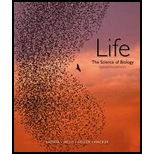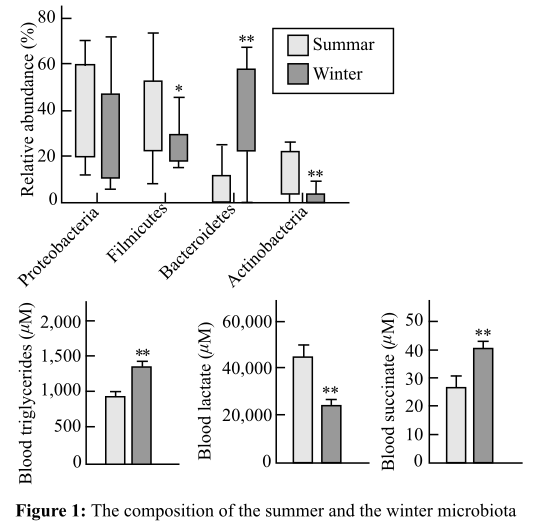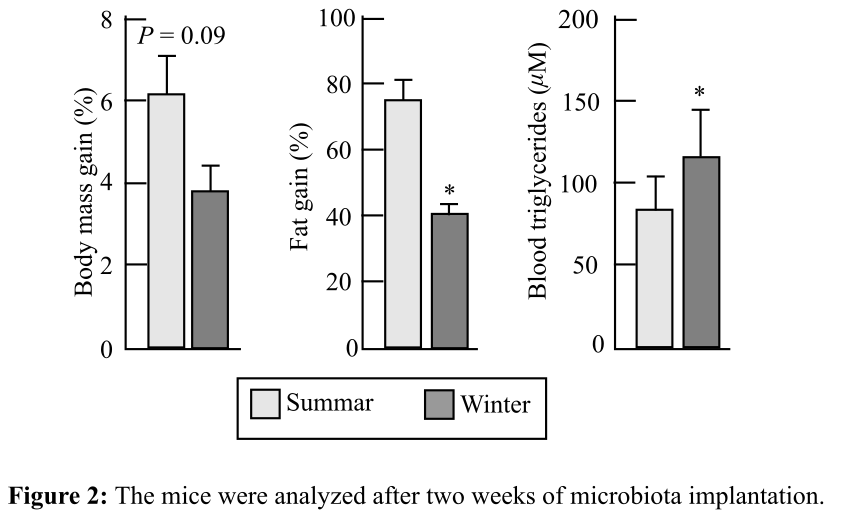
To review:
The difference between the outcomes from summer versus winter microbiota and a hypothesis to explain it.
Given:
Researchers, for their study, took the brown bears (Ursus arctos) for the role of gut microbiota in the digestion of food and in many other aspects of nutrition. Brown bears have the ability of hibernating when the environment is drastically cold. Researchers studied if the gut microbiome of the bear has some difference before and after fasting. For this, the scientists studied the fecal and the blood samples of about 16 brown bears during hibernation, which starts from February and continued their study till June of following hibernation year. They found the presence of the different microbe communities in different amounts during different seasons and same was with the triglycerides and other nutrients.
The following graphs were plotted after observing the conditions in winters and summers. Figure 1 shows the presence of different composition of the microbiome during different seasons. Also, the differences in the blood levels of triglycerides, lactate, and succinate are depicted.
The effects of the microbiota were also examined after introducing them into germ-free mice. Germ-free mice, unlike normal mice, are devoid of gut microbiota and are unable to gain mass when they are kept on a high-fat diet. Fecal transplants from summer and the winter bears were given to the germ-free mice. Figure 2 shows the changes in body mass, fat content, and blood triglyceride levels of the mice after 2 weeks.


Introduction:
Germ-free mice are those mice that do not have any microbes in their gut. These mice are different from the normal mice as they are unable to gain weight when kept on a high-fat diet. These mice are used for the experiment and introduced with the microbiota of summer bears and winter nears. The difference in the microbiota leads to the difference in the body mass of the mice
Want to see the full answer?
Check out a sample textbook solution
Chapter 50 Solutions
Life: The Science of Biology
- What did the Cre-lox system used in the Kikuchi et al. 2010 heart regeneration experiment allow researchers to investigate? What was the purpose of the cmlc2 promoter? What is CreER and why was it used in this experiment? If constitutively active Cre was driven by the cmlc2 promoter, rather than an inducible CreER system, what color would you expect new cardiomyocytes in the regenerated area to be no matter what? Why?arrow_forwardWhat kind of organ size regulation is occurring when you graft multiple organs into a mouse and the graft weight stays the same?arrow_forwardWhat is the concept "calories consumed must equal calories burned" in regrads to nutrition?arrow_forward
- You intend to insert patched dominant negative DNA into the left half of the neural tube of a chick. 1) Which side of the neural tube would you put the positive electrode to ensure that the DNA ends up on the left side? 2) What would be the internal (within the embryo) control for this experiment? 3) How can you be sure that the electroporation method itself is not impacting the embryo? 4) What would you do to ensure that the electroporation is working? How can you tell?arrow_forwardDescribe a method to document the diffusion path and gradient of Sonic Hedgehog through the chicken embryo. If modifying the protein, what is one thing you have to consider in regards to maintaining the protein’s function?arrow_forwardThe following table is from Kumar et. al. Highly Selective Dopamine D3 Receptor (DR) Antagonists and Partial Agonists Based on Eticlopride and the D3R Crystal Structure: New Leads for Opioid Dependence Treatment. J. Med Chem 2016.arrow_forward
- The following figure is from Caterina et al. The capsaicin receptor: a heat activated ion channel in the pain pathway. Nature, 1997. Black boxes indicate capsaicin, white circles indicate resinferatoxin. You are a chef in a fancy new science-themed restaurant. You have a recipe that calls for 1 teaspoon of resinferatoxin, but you feel uncomfortable serving foods with "toxins" in them. How much capsaicin could you substitute instead?arrow_forwardWhat protein is necessary for packaging acetylcholine into synaptic vesicles?arrow_forward1. Match each vocabulary term to its best descriptor A. affinity B. efficacy C. inert D. mimic E. how drugs move through body F. how drugs bind Kd Bmax Agonist Antagonist Pharmacokinetics Pharmacodynamicsarrow_forward
 Human Heredity: Principles and Issues (MindTap Co...BiologyISBN:9781305251052Author:Michael CummingsPublisher:Cengage Learning
Human Heredity: Principles and Issues (MindTap Co...BiologyISBN:9781305251052Author:Michael CummingsPublisher:Cengage Learning Principles Of Radiographic Imaging: An Art And A ...Health & NutritionISBN:9781337711067Author:Richard R. Carlton, Arlene M. Adler, Vesna BalacPublisher:Cengage Learning
Principles Of Radiographic Imaging: An Art And A ...Health & NutritionISBN:9781337711067Author:Richard R. Carlton, Arlene M. Adler, Vesna BalacPublisher:Cengage Learning





